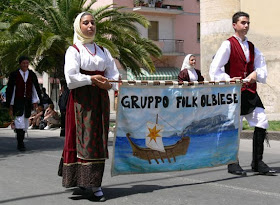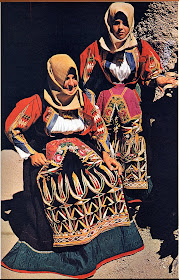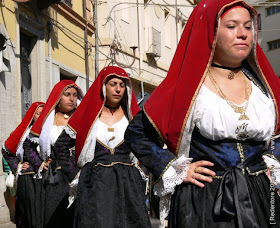I am going to change focus for a while. There is much left to say about Lithuania and the Baltic area, and i will return to it.
Research of Italian costume is quite challenging, as in many places in Italy, there has long been little interest in maintaining this part of their culture. Another factor is that the large cities of Italy have always been in the forefront of developing the latest fashion. Because the local folk costume is further in time from current memory than some other places, there is less material available.
Italy can be divided into 4 regions when it comes to folk costume. Northern, Central, South, and Sardinia.
The north is characterized by costumes that fall within the general Alpine culture. There are several linguistic minorities that inhabit this region, Franco-Provencal in Aosta, Tyrolean Austrians in Alto Adige, Ladins just to the east of them, Friuli [Furlan] in the northeast corner, and Slovenian in the valley of Resia. Many communities have tenaciously clung to their folk costume as a part of their identity. To the south is the wide and very fertile valley of the Po river, which has been so much in the center of the general development of European fashion and history that little distinctive peasant culture has developed or survived.
The center includes the hilly country from Tuscany to Molise. There are some notable costumes preserved in this area, including Pescocostanza with their beautiful lace, Assisi with its distinctive embroidery, Scanno whose costume is derived from the middle East, and others.
The south includes Basilicata, Puglia, Catania, Calabria and Sicily, with some very colorful and rich costumes. Some of the most impressive are those of the Arbereshe, the Albanian ethnic minority which have developed their own distinctive costumes.
Sardinia, however, is the jewel of folk costume in Italy, having easily as many variants of folk costume as the entire mainland combined. Sardinia is currently divided into 8 provinces, and i will be presenting a short overview of only a handful of costumes from each. I was forced to leave out much material.Here is a map of Sardinia, showing the provinces and the major cities. You will notice that each location has two labels, the one on top is in Italian, while the one underneath is in the Sardinian language.
Although Sardinia has been politically part of Italy for quite some time, the Sardinian language is only very remotely related to Italian. Castillian and French are both more closely related to Italian than Sardo is. In addition, there is a Catalonian colony in and around the city of Alghero, in the northwest corner, Genovese speaking communities in the far southwest, and a Corsican speaking community in the far north.
Several times a year there occur large festivals in various places around the island. The largest is the Cavalcata Sarda. Representatives from various communities attend, and they all march in parade at some point of each festival. This provides an incredible photo opportunity, as well as an amazing chance to view the rich variety of costumes. If you want to glut yourself on a surfeit of such photos, here is a wonderful website. I will be presenting some photos from this site, as well as from other sources.
For ease of reference, i will present the material under the place names in Italian rather than Sardo, with apologies to the purists. I will proceed roughly north to south.
Olbia-Tempio
named after the two largest cities of the province.
Here is a sober but elegant costume of Tempio Pausania
The mens costume, which is found all over the island with minor variations. It also includes a long soft cylindrical stocking cap, which he is either holding or has tucked into his belt. The most striking feature are the short overpants which resemble a kilt, or woolen foustanella.
Olbia
. Many of these folk groups carry banners when participating in the parades.
Sassari
Ittiri
The pink panels are ribbons lacing the bodice together. The oversized silver buttons on the woman's sleeve are unique to this area.
Ploaghe
Notice the cross on the headcloth, typical of this area. The embroidery on the back of the bodice shows some of the incredible handwork found all over Sardinia.
Bonnanaro
As close to the 'typical' Sardinian costume as one can get.
Osilo
The elaborately embroidered head shawl is only worn on festive occasions.
The Province of Nuoro
In my opinion, this province contains some of the most spectacular costumes in all of Sardinia.
Orgosolo
This to me has a very 'Art Deco' look.
Aritzo
Print by Emma Calderini. The present day costume is essentially the same.
Atzara
Oliena
which has a unique way of wearing the embroidered head shawl.
The Province of Oristano
Cabras
In this seacoast town, the local folk group calls itself the 'Scalzi', they are unique in that the men wear red kilts instead of black, and they insist on marching and performing barefoot.
Samugheo
The girl's headress consists of several kerchiefs rolled up and arranged at various angles. The married woman's headdress is visible at left.
Busachi
[in Italian, an H is inserted between a G or a C and a following I or E to indicate that it is to be pronounced hard. So this is pronounced 'Buzakee'.] More modest than some of the Sardinian costumes, but quite attractive. The man has his stocking cap rolled up. This is one of the typical ways that this hat is worn.
City of Oristano
Again, one of the more spectacular costumes of the island. Two variants of the woman's costume are shown.
The Province of Ogliastra
[The G is NOT pronounced, but palatalizes the L, just as it does in the word Lasagna. This is always the case in Italian. I admit that this is one of my pet peeves.]
Villagrande Strisaili
Note the headdress, which seems to be a mini apron. This is also found in some other areas, and oddly enough, also in Poland.
Lotsorai
Urzulei
Ussassai
The Province of Medio Campidano
Arcidano
Collinas
You have to admire those saddlebags
Gesturi
Sanluri
Notice the men with leather kilts, vests, gaiters, and stiff hats.
Tuili
Note the sheepskin vests on the men and the elaborately embroidered shawls on the women.
Province of Carbonia-Iglesias
Iglesias women.
The blue and white headress is distinctive for this area.
Iglesias men.
In the entire southwest corner of the island, the 'kilts' are replaced by Spanish style 'Sobrapantalones'. Sardinia was under Spanish domination for some time. Or perhaps the 'kilts' are just shortened versions of the Sobrapantalones.
Sant'Antioco
A closer look at the Sant'Antioco costume. Notice the rich brocades and the lavish jewelry.
[Is it just me, or does that look like a blanket on her head?]
Domusnovas

Nuraxi Figus
Province of Cagliari
Teulada
There is a strong Spanish influence on the men's costume of this area. Not only do they wear the sobrapantalones, but they also wear a hat instead of the stocking cap, which they call 'sombrero'. They also wear beautifully embroidered vests.
Isili
Villaputzu
Silanus
The half circle of cities and towns around Cagliari have basically two costumes which they share between them with small local variations. Here are a couple of examples of the 'plain' costume. This first one is from Settimo San Pietro. I do not know the exact provenance of the other. The 'plain' costume is characterized by the skirt with blue and red stripes.
Here are a couple examples of the 'fancy' costume. The first one is from Quartu Sant'Elena, and the second from Quartucciu. Notice the traditional chain worn by married couples, and the multitude of other jewelry.
City of Cagliari
The city itself has its own distinctive costume.
Thank you for reading. I hope that you have found this interesting and enjoyable. This overview is FAR from exhaustive. There are many costumes which i had to omit due to lack of space, several of which are just as striking, colorful and elaborate as any of the ones i chose to portray.
Feel free to contact me with requests for research. I hope to eventually cover all of Europe and the Former Russian Empire/Soviet Union. I also gratefully accept tips on source materials which i may not have. I also accept commissions to research/design, sew, and/or embroider costumes or other items for groups or individuals
Roman K.
Rkozakand@aol
This is a link to a website dedicated to photographs of Sardinia. This website presents many facets of the culture of Sardinia.There are literally thousands of photographs posted. I freely acknowledge that this website is one of my sources for this posting. It is called 'Cattura la Sardegna' [Capture Sardinia] at Paradisola. It
Other Source Material:
Chiara Samugheo, 'Costumi di Sardegna', L'Unione Sarda, 1987
Otto Jenny, 'Sardinien, Insel der Trachten', Zurich, 1962
Luca Villani et al, 'Vecchia Sardegna', Ivrea, 1979
Manilio Brigaglia et al, 'Sardegna', Milan, 1981
Emma Calderini, 'Il Costume Popolare in Italia', Milan,
Anna Maria Colomo, 'I Costumi della Sardegna', Nuoro, 1983
Paolo Piquereddu, 'Costumi' Ilisso Publishing, Nuoro, 2003
















































Awesome photos and explanations on lovely people of Sardigna. What a lovely culture and tradition, may it last for ever. Viva Sardigna, It.
ReplyDeleteMy father is from Genova what costume represents that area please? Thank you
ReplyDeleteThis comment has been removed by the author.
ReplyDeleteThank you for posting all this amazing information, the Sardinian costumes' beauty and variety are not rivaled. There is a very notable one missing, however: The one from Desulo, which is very colorful, mostly red and orange with some yellow and blue touches. I think that single women wear a cap with those colors, whereas married women wear a black cape.
ReplyDeleteI’ve been reading Sea and Sardinia by DH Lawrence first published in 1921 & it’s so fascinating to read about the many costumes of the places he travelled through then be able to find your pics and see what he saw for myself. Amazing :)
ReplyDelete